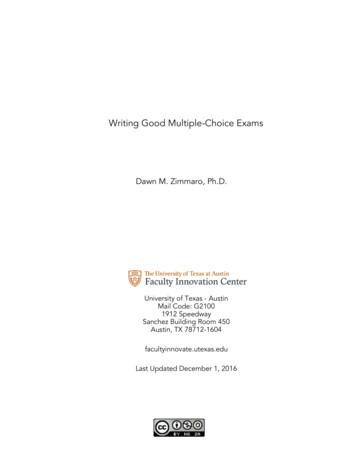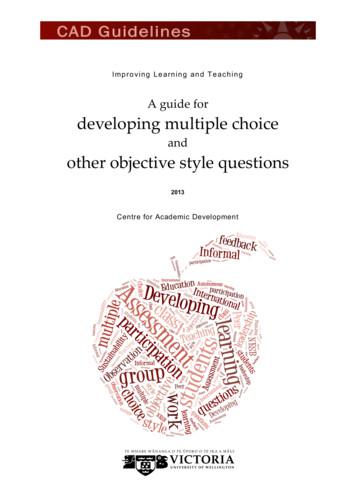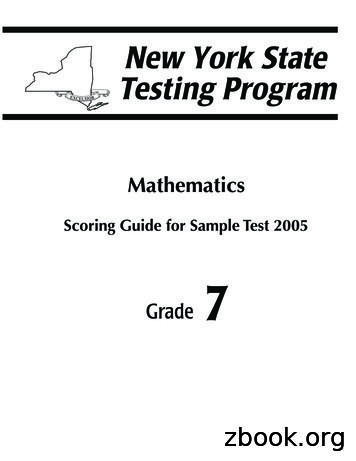Big Idea 2: Multiple Choice Big Idea 2A - AP Biology
Big Idea 2: Multiple ChoiceBig Idea 2A1. Various materials are transported into and out of cells by simple diffusion.The rate at which these materials diffuse is related to the surface area tovolume ratio of the cell. Which of the following cube-shaped cells would bemost efficient at removing waste by diffusion?a. L 0.02 mmb. L 0.04 mmc. L 0.03 mm x W 0.02 mmd. L 0.06 mm x W 0.04 mmSmall nonpolar molecules can pass through the phospholipid bilayer of a cell. A cellis placed in a solution containing the following compounds:I.KClII.GlucoseIII.CO2IV.H2CO3V.O22. Which compounds will diffuse across the cell membrane without the aid ofintegral proteins?a. V onlyb. III, Vc. I, III, Vd. II, III, V3. The cell is genetically modified to contain only integral proteins withhydrophilic side chains. Which compounds will diffuse into the cell?a. I, II, IIIb. I, II, III, Vc. I, III, IV, Vd. I, II, III, IV, Vwww.njctl.orgAP BiologyBig Idea 2
4. Bacterial cells and plants cells are less likely than animal cells to lyse in ahypotonic environment because:a. The cells have mechanisms which actively transport water outside thecellb. Bacteria and plant cells have plasma membranes less permeable towater than most animal cellsc. These cells increase their rates of photosynthesis in hypotonicenvironmentsd. Bacterial cells and plants cells are surrounded by cell walls whichprovide support to the cell membrane under high osmotic pressureAn artificial cell consisting of an aqueous solution enclosed in a selectivelypermeable membrane is immersed a beaker containing a different solution. Themembrane is permeable to water and the simple sugars, glucose and fructose. Themembrane is impermeable to the disaccharide, sucrose.5. Which of these experimental treatments would increase the rate of glucosetransport into the cell?a. Increasing extracellular glucose concentrationb. Decreasing extracellular pHc. Increasing cytoplasmic pHd. Adding an inhibitor that blocks the regeneration of ATP6. Which of these experimental treatments would result in the most turgid cell?a. Increasing the temperature of the systemb. Increasing the intracellular sucrose concentrationc. Decreasing the extracellular simple sugar concentrationd. Decreasing cytoplasmic pH7. Facilitated diffusion and active transport both rely on proteins embedded inthe phospholipid bilayer of the cell. Which of the following statementsprovides the best explanation of the differences between active transportand facilitated diffusion?www.njctl.orgAP BiologyBig Idea 2
a. Active transport is powered by ADP phosphorylation while facilitateddiffusion is powered by the hydrolysis of ATPb. Active transport is powered by the hydrolysis of ATP while facilitateddiffusion is powered by anabolic reactions of cellsc. Facilitated diffusion moves molecules with their concentrationgradient until equilibrium is reached; active transport movesmolecules against their concentration gradientd. Facilitated diffusion moves molecules from areas of highconcentration to areas of low concentration; active transport usesATP hydrolysis to move molecules from areas of low concentration toareas of high concentration8. Choose the pair of terms that correctly completes this sentence:Catabolism is to as is to endergonica. Exergonic; spontaneousb. Anabolic; exergonicc. Work; energyd. Entropy; enthalpy9. Living systems do not violate the second law of thermodynamics, whichstates the entropy increases over time. Which of the following statementssupports this statement?a. Order is maintained in photosynthetic organisms by coupling cellularprocesses that increase entropy with decreases in the amount ofultraviolet radiation absorbed by the organismb. Energy input must exceed free energy lost to entropy to maintainorder and power cellular processesc. Exergonic reactions, such as ATP ADP are powered by endergonicreactionsd. Metabolic processes are catalyzed by enzymes thus decreasing theentropy of the system10. If an enzyme in solution is saturated with substrate. The most effective wayto obtain a faster yield of products is toa. Add more enzymeb. Heat the solution to 90Cc. Add more substrated. Add an allosteric inhibitorwww.njctl.orgAP BiologyBig Idea 2
11. According the flow chart tothe left, which of the following isnot true of catabolic reactionwithin the cell?a. The metabolism ofall foods produce ammonia andcarbon dioxide as waste productsb. The metabolism ofall foods produce acetyl CoA forthe Krebs cyclec. Only simple sugarsare processed through glycolysisd. Protein catabolismcreates substrates for thepyruvatedehydrogenasecomplex and theKrebs cycle12. Using the flow chart aboveto determine the waste products of protein catabolism.a. NH3b. NH3, ATPc. NH3, H2Od. NH3, H2O, CO213. Tryptophan can inhibit the activity of the first enzyme in metabolic pathwaythat builds tryptophan in the body. Which chemicalpathway shown to the left illustrates this feedbackmechanism?a. 1b. 2c. 3d. 514. Cholesterol is broken down by animal cellsinto bile acid. The “classical” pathway for thecatabolism of cholesterol is initiated by thehydroxylation of the molecule at the 7 position.www.njctl.orgAP BiologyBig Idea 2
When this pathway is inhibited, cholesterol follows an “acidic” pathwaywhich is initiated by the hydroxylation of the molecule at the 27 position.Which chemical pathway, shown for question 13, illustrates this catabolicpathway?a. 1b. 2c. 3d. 415. Thermoplasmatales picrophilus is the most acidophilic of all knownorganisms on Earth. These archaea can live in environments with a pH aslow as 0.6. Which of the following statements is likely true about thisorganism?a. They are capable of maintain an internal pH much higher than that ofthe surrounding environmentb. Their enzymes have a low optimal pHc. Their enzymes are insensitive to pHd. They use molecules other than proteins as their main catalysts16. Which of the following metabolic processes cannot occur without a net influxof energy from some other process?a. ATP H2O ADP Pib. C6H12O6 6O2 6CO2 6H2Oc. 6CO2 6H2O C6H12O6 6O2d. sucrose fructose glucoseBig Idea 2B17. Which of the following statements is a correct distinction between cyclic andnoncyclic photophosphorylation?a. Only noncyclic photophosphorylation produces ATPb. In addition to ATP, noncyclic photophosphorylation also produces O2and NADPHc. Chemiosmosis is unique to noncyclic photophosphorylationd. Only cyclic photophosphorylation can operate in the absence ofphotosystem II18. Which of the following correctly sequences the steps of non-cyclic electrontransport?a. Chlorophyll molecules absorb UV radiation exciting electrons whichflow through photosystem I, returning to the chlorophyll moleculesb. Electrons donated from water molecules pass through photosystem Ithen photosystem II before returning to the chlorophyll molecules,generating ATP in the processc. The ATP and NADPH generated by the reactions of photosystem II andphotosystem I are utilized by the Calvin Cycle to build high energyglucose moleculeswww.njctl.orgAP BiologyBig Idea 2
d. Water is oxidized by the capture of light energy; these excitedelectrons are passed through the dark reactions, returning tochlorophyll during the final light reactions19. Prokaryotic photosynthetic pathways were the foundation of eukaryoticpathways. All of the following support this statement except:a. Chloroplasts are surrounded by a double membraneb. The genetic material of chloroplasts replicates independently of thehost cellc. Photosynthetic prokaryotes contain structures similar to photosystemI and photosystem IId. Photosynthetic eukaryotes use chlorophyll to excite electrons, whilecyanobacteria use phycobilins to perform the same functionAn experiment was conducted to determine the factors affecting aerobic respirationin a facultative aerobe. Under aerobic conditions, the rate of carbon dioxideproduction was determined at 5 minute intervals. A graph of the results is shownbelow.1.210.8Control0.6Citrate AddedATP Removed0.4AMP Added0.200510152020. Which of the following best explains the above results?a. ATP and citrate are allosteric inhibitors in the cellular respirationprocess, while the presence of AMP stimulates respirationb. ATP and AMP stimulate respiration, while citrate inhibits this processc. Citrate stimulates the production of CO2 by stimulating fermentationin the bacterial cellsd. The presence of ATP and AMP have little effect on the process ofcellular respiration21. Oxygen is removed from the environment. Which of the following wouldmost likely occur?www.njctl.orgAP BiologyBig Idea 2
a. The production of carbon dioxide in the “AMP added” system wouldincreaseb. The production of carbon dioxide in the “ATP removed” system wouldincreasec. The production of carbon dioxide in the “control” system woulddecrease and level offd. The production of carbon dioxide in the “control” system wouldincrease and level off22. Most CO2 from catabolism is released during?a. Glycolysisb. The Krebs Cyclec. The Calvin Cycled. The light dependent reactions23. Photosynthesis and aerobic cellular respiration both rely on electrontransport chains to generate ATP. Which of the following does not correctlyidentify similarities and differences in the ETCs of these processes?a. Electrons delivered to the ETC are used to generate a proton gradientacross the membraneb. In photosynthesis, electrons are delivered to the ETC by NADPH; incellular respiration, electrons are delivered to the ETC by NADH andFADH2c. In prokaryotes, active transport moves protons across the cell’splasma membrane during photosynthesis and cellular respirationd. In photosynthesis, the facilitated diffusion of protons across themembrane generates ATP and glucose molecules; in cellularrespiration, this process generates ATP24. Chemosynthetic autotrophs and photosynthetic autotrophs are similar inthat they both capture free energy to produce organic compounds. Thebalanced chemical equation for hydrogen sulfide chemosynthesis is asfollows: CO2 O2 4H2S CH2O 4S 3H2O. Which of following correctlycontrasts photosynthesis and chemosynthesis?a. In photosynthesis oxygen gas is the final electron acceptor, while inchemosynthesis hydrogen sulfide is the final electron acceptorb. In chemosynthesis water is a final product, while in photosynthesiscarbon dioxide is a final productc. Photosynthetic organisms rely on free energy from sunlight to buildorganic compounds, while chemosynthetic organisms produceorganic compounds using heat energyd. Chemosynthetic organisms capture energy from inorganic molecules,such as hydrogen sulfide, while photosynthetic organisms captureenergy present in sunlightwww.njctl.orgAP BiologyBig Idea 2
25. When making wine, yeast is added to grape juice. As time passes, the yeastuses up all of the oxygen in the flask, but continues to thrive and producealcohol. Which of the following statements best explains this process?a. Yeast has evolved the ability to uses other electron acceptors in theabsence of oxygenb. Yeast is a facultative anaerobe, able to switch to fermentation in theabsence of oxygenc. In the absence of oxygen, yeast participates in a symbioticrelationship with anaerobic bacteriad. Fructose stimulates alcohol production in yeastBig Idea 2C26. The metabolic requirements of cells impose upper limits on the size that ispractical for a single cell. Eukaryotic cells have increased this upper limit byall of the following except:a. Possessing extensive and elaborate internal membranesb. Compartmentalizing chemical reactions in organellesc. Evolving double membranes in the organelles of the celld. Embedding enzymes directly into membranes to facilitate localmetabolic reactions27. Cyanide binds with at least one of the molecules involved in the productionof ATP. Following exposure to cyanide, the cyanide would accumulate whichpart of the cell?a. Mitochondriab. Ribosomesc. Lysosomesd. Endoplasmic reticulum28. Bacteria and archaea generally lack internal membranes and have a cell wall.Which of the following statements is an incorrect?a. Protein catalysts are embedded in the cell wall to speed up metabolicreactionsb. The upper size limit of bacteria and archaea is generally lower thanthat of plant and animal cellsc. To perform aerobic cellular respiration, prokaryotes pump ions intothe space between the plasma membrane and the cell walld. All metabolic reactions in these cells occur in the cytoplasmwww.njctl.orgAP BiologyBig Idea 2
The diagram to the left illustrates Neuron Atransmitting a signal to Neuron B.29. Which of the following correctly describes the transport ofneurotransmitter out of Neuron A?a. The vesicle (2) fuses to the membrane (7) emptying its contents intothe synaptic cleft (4)in a process called exocytosisb. Using endocytosis, Neuron A passively transports the chemicals intothe synaptic cleft (4)c. The vesicle (2) facilitates diffusion of the neurotransmitter throughthe channel protein (3)d. Simple diffusion occurs at the membrane (7) moving theneurotransmitter with its concentration gradient30. Referring to the diagram above, for signal transduction to occur Neuron Bmust uptake ions from the synaptic cleft (4). Which of the following correctlydescribes the transport of these ions into Neuron B?a. Ions diffuse directly across the phospholipid bilayerb. The ions must be actively transported through the integral proteins(5)c. The neurotransmitter actives the integral proteins (5) openingchannels to ion flowd. The ions enter Neuron B through endocytosisThe vulva is the opening through which the nematode lays its eggs. Precursor cellsin the larvae required a series of inductions initiated by a chemical signal from anearby cell called an anchor cell. The binding of this first inducer to receptors onthe nearest vulval precursor cells signals these cells to develop into the inner vulva.In addition, this binding triggers a
www.njctl.org AP Biology Big Idea 2 Big Idea 2: Multiple Choice Big Idea 2A 1. Various materials are transported into and out of cells by simple diffusion. The rate at which these materials diffuse is related to the surface area to volume ratio of the cell. Which of the following cube-shaped cells would be
Idea 22 Idea 3 Idea 14 Idea 7 Idea 25 Idea 9 Idea 11 Idea 3 Idea 31 Idea 8 Idea 12 Idea 27 Idea 17 Idea 32 Idea 5 Idea 6 My Ideas Browse Following How it Works Log In/Sign Up New Visitor / Landing Page Validate and get insightful feedback on your business idea. Help other entrepreneurs with their business ideas. How it works Browse Sign Up .
Big Idea 1: Multiple Choice Big Idea 1A 1. Which of the following is not an observation or inference upon which natural selection is based? a. There is heritable variation among individuals. b. Poorly adapted individuals leave less offspring. c. The size of populations fluctuates over time. d. Individuals whose inherited characteristics best .
Test Blueprint 10 Preparing to Write Items 11 Description of Multiple-Choice Items 12-15 Multiple-Choice Item Writing Guidelines 16-18 Guidelines to Writing Test Items 19 Sample Multiple-Choice Items Related to Bloom’s Taxonomy 21-23 More Sample Multiple-Choice Items 24-25 Levels of Performance and Sample Prototype Items 26 Good versus Poor Multiple-Choice Items 27-28 Activity: Identifying .
Developing multiple choice and other objective style questions 4 2. Writing multiple choice questions THE FORMAT of a multiple choice question Multiple choice questions are the most commonly used format for presenting objective-style questions. A multiple choice question consists of two parts ñ A stem and several options or alternatives.
(music begins to “What’s the Big Idea?”) ABIGAIL: What is it this time, Shiloh? SONG: “What’s the Big Idea?” chorus 1 Hey, what’s the big idea? There’s gotta be something in the works, we know you Say, what’s the big idea? You’ve always been looking for your big bre
50 multiple choice. 5. field test 40 multiple choice field test 46 ITEMS/40 POINTS 45 ITEMS/40 POINTS 55 ITEMS/50 POINTS 45 ITEMS/40 POINTS. 12 Students compose two essays one, for each of. two writing prompts. 40. multiple choice. 5. field test. 49. multiple choice. 1. open ended. 6. field test 50 multiple choice. 5. field test 40 multiple .
Grade 7, Book 1 Question Type Points Strand Content Performance Indicator Answer Key 1 Multiple Choice 1 Number Sense and Operations 7.N.9 C 2 Multiple Choice 1 Algebra 7.A.1 G 3 Multiple Choice 1 Statistics and Probability 6.S.3 A 4 Multiple Choice 1 Number Sense and Operations 7.N.6 H 5 Multiple Choice 1 Geometry 7.G.3 B
PASSOVER BLUEBERRY MUFFINS (Alexa & Riley Newbold) Ingredients: -1/3 cup butter -1 scant cup of sugar -3 eggs -1/2 teaspoon vanilla -1/2 cup matzo cake meal -1/4 cup potato starch -1/4 teaspoon salt -1 cup blueberries (frozen, drained)— don’t defrost -Cinnamon sugar . Directions: Cream sugar and butter. Add three eggs one at a time, beating after each. Add vanilla and mix. Add matzo cake .























